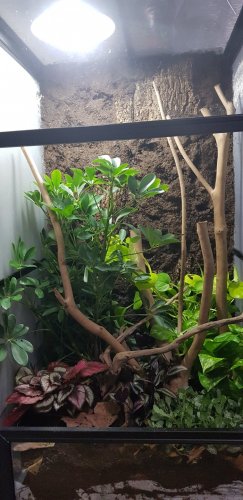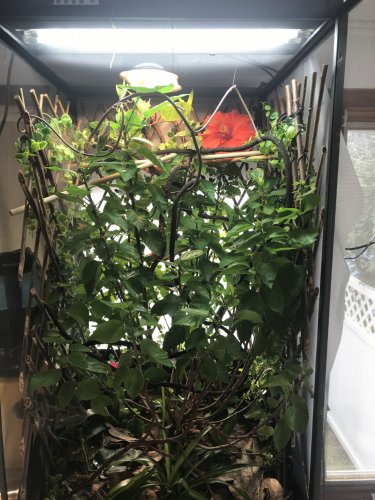Navigation
Install the app
How to install the app on iOS
Follow along with the video below to see how to install our site as a web app on your home screen.
Note: This feature may not be available in some browsers.
More options
You are using an out of date browser. It may not display this or other websites correctly.
You should upgrade or use an alternative browser.
You should upgrade or use an alternative browser.
Bioactive vivarium for veiled chameleon
- Thread starter Zevil
- Start date
bobbydigital
Avid Member
@jamest0o0 has some great info on bioactive enclosures
@jamest0o0 has some great info on bioactive enclosures
Thank you. My friend has a pot of devil's ivy. Can I use that?
ERKleRose
Chameleon Enthusiast
Just a warning, veileds are notorious for eating substrate, not making them the best candidates for bioactive. So just be careful and if he/she eats it, go to a bare bottom enclosure. Here’s a cham-safe plant list: https://flchams.com/chameleon-safe-plant-list/ Have you read the veiled care sheet here? https://www.chameleonforums.com/care/caresheets/veiled/ Could you fill out this form, as well, to make sure your husbandry is 100%, please? https://www.chameleonforums.com/how-ask-help-66/ If you need any help, I use bioactive for my panthers, too.
ERKleRose
Chameleon Enthusiast
Yes you can, another name for it is pothos, which is cham-safeThank you. My friend has a pot of devil's ivy. Can I use that?
ERKleRose
Chameleon Enthusiast
Those are all great plants that are cham-safe and look good in a bioactive enclosure, as well!So I'm getting a veiled. May I have suggestions on what kind of plants can I put inside the vivarium? I'm thinking pothos, bromeliad and fittonia. Thanks.
Those are all great plants that are cham-safe and look good in a bioactive enclosure, as well!
Thanks for all your replies! Yes I'm aware that animals in bioactive enclosures can get impaction from eating the substrate. First of all, there is no way I will do free range feeding. And second, the leaf litter will also reduce the chance of my future cham from eating the substrate. Also I believe a healthy cham will not resort to eating the substrate.
ERKleRose
Chameleon Enthusiast
Make it 3 inchesI have another question. Currently I made an inch of clay balls for drainage and people are telling me to increase to 3 inches. Is there really a need? I live in a warm and humid area btw with an average of 28-30℃ and 70-85% humidity daily.
Goose502
Chameleon Enthusiast
I would use at least 1.5 inches. It’s hard to tell what will work best for you as everyone uses different amounts of water for misting/maintaining humidity. As long as you have a way of removing excess water, the drainage layer can be modified to suit your need. Unfortunately, using bioactive substrate requires a little trial and error. My thought has always been that more soil means more plants and roots. The more plants you have, the more water they will absorb. So if you mist very heavily, you may need to drain your substrate much more often when you first plant, as opposed to a year down the road when the plant life has properly filled in.
I would use at least 1.5 inches. It’s hard to tell what will work best for you as everyone uses different amounts of water for misting/maintaining humidity. As long as you have a way of removing excess water, the drainage layer can be modified to suit your need. Unfortunately, using bioactive substrate requires a little trial and error. My thought has always been that more soil means more plants and roots. The more plants you have, the more water they will absorb. So if you mist very heavily, you may need to drain your substrate much more often when you first plant, as opposed to a year down the road when the plant life has properly filled in.
Well maintaining humidity is not a problem, I live in a humid area so the enclosure won't be heavily misted. I also intend to have 9 inches of substrate in a 2x2 feet area and lots of plants.
Goose502
Chameleon Enthusiast
Misting, and misting heavily is recommended to allow the chameleon to properly clean their eyes. I personally get around this by using an outdoor enclosure during part of the year. I can leave the hose running forever and it wouldn’t hurt anything. In an indoor enclosure, periodic misting sessions of 5-10 minutes (a couple times a week or so), can, and most likely will stretch a drainage layer to its limits. This will be very problematic early, when your plants are still young. I don’t ever have an issue with humidity either, but we aren’t misting to solely maintain humidity.Well maintaining humidity is not a problem, I live in a humid area so the enclosure won't be heavily misted. I also intend to have 9 inches of substrate in a 2x2 feet area and lots of plants.
ERKleRose
Chameleon Enthusiast
Make a feeding cup/jug/pipe with drainage in the bottom. Put the bowl in the least misted part of the cage. Full Throttle Feeders sells a PVC pipe feeder with drainage that works well. I made my own version that works just as well, too.I have a question. I have an exo terra feeder dish, with regular misting, the water will get into the dish and possibly soak the calcium dust and drown the feeder insects. Any solution to this?
Jordanworks479
Established Member
Looks great I love begonia Rex my favorite terrarium plant.
What’s the dimensions on that?
I think you have a perineal hibiscus they wilt during the winter try a red darling they bloom huge flowers year round (pic below).
You can replace it with orchards they do well in terrariums imo.
What’s the dimensions on that?
I think you have a perineal hibiscus they wilt during the winter try a red darling they bloom huge flowers year round (pic below).
You can replace it with orchards they do well in terrariums imo.
Attachments
Similar threads
- Replies
- 15
- Views
- 2K


